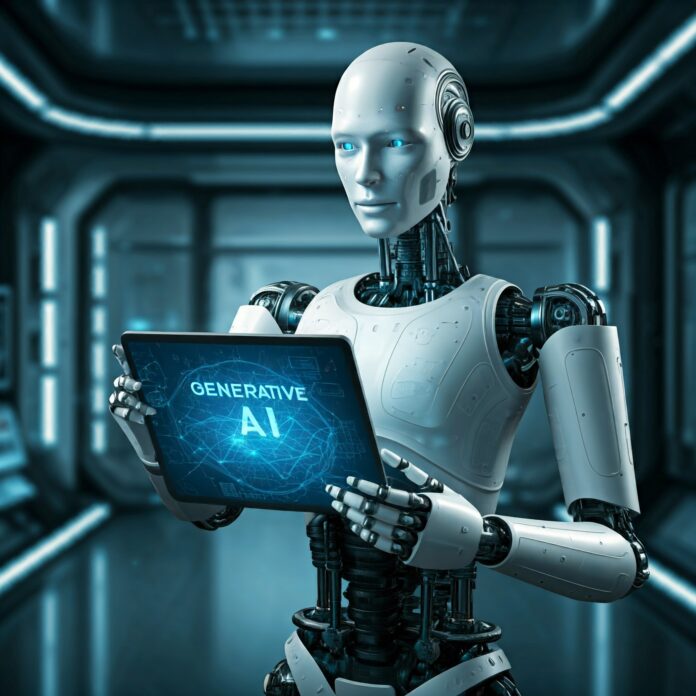In 2023, generative AI technologies processed more than 500 billion data points, transforming industries ranging from healthcare to entertainment. This increase highlights a significant change in our approach to creation, interaction, and tackling complex challenges. Advanced language models, fundamental to generative AI, have proved essential in automating tasks, boosting creativity, and fostering innovation across multiple sectors.
Also Read Our Other Blog
Importance Of AI Technologies:
Generative AI and advanced language models represent the forefront of artificial intelligence advancements. Unlike traditional AI systems that depend on fixed rules and restricted datasets, generative AI utilizes deep learning algorithms to create original content, emulate human-like comprehension, and adapt to various applications. This evolution is crucial as it enables more interactions between humans and machines, enhancing efficiencies and unlocking new possibilities that were previously unattainable.
Blog Purpose: Empowering Readers with Knowledge and Insights
In this blog we will explore the mechanics, applications, and implications of these groundbreaking technologies. Readers will acquire a thorough understanding of how generative AI and advanced language models function, investigate their real-world applications, evaluate the benefits and challenges they present, and gain insights into future trends shaping the AI landscape. Whether you are a tech enthusiast, a professional in the field, or simply curious about AI’s potential, this guide aims to provide you with the knowledge needed to navigate and leverage these technologies effectively.
Understanding Generative AI and Advanced Language Models
To grasp the full potential and applications of artificial intelligence, it’s essential to understand two pivotal components: Generative AI and Advanced Language Models. This section delves into their definitions, examples, and the intricate ways they differ and interrelate.
What is Generative AI?
Definition and Basic Concept
Generative AI refers to a class of artificial intelligence technologies designed to create new content by learning patterns from existing data. Unlike traditional AI systems that perform specific tasks based on predefined rules, generative AI leverages advanced algorithms to produce original outputs that can range from text and images to music and beyond. The core idea is to enable machines to generate content that is not only coherent but also creative and contextually relevant.
Examples of Generative AI
- Image Generation:
DALL·E 2: Developed by OpenAI, DALL·E 2 can create highly realistic images from textual descriptions. For example, it can generate an image of “a futuristic cityscape at sunset” with intricate details. Learn more about DALL·E 2
- Music Creation:
Amper Music: This platform allows users to compose original music by selecting various parameters such as mood, genre, and instrumentation. It’s widely used for creating background scores for videos and games. Explore Amper Music
- Text Generation:
GPT-4: An advanced language model that can generate human-like text, write essays, create poetry, and even draft complex technical documents based on prompts provided by users. Discover GPT-4
- Video Synthesis:
Synthesia: This AI tool can create synthetic videos by generating realistic avatars that can speak in multiple languages, useful for creating training videos and marketing content.

What are Advanced Language Models?
Definition and Basic Concept
Advanced Language Models are sophisticated AI systems designed to understand, interpret, and generate human language in a meaningful way. These models are built using deep learning techniques, particularly leveraging neural network architectures like transformers. Their primary function is to process vast amounts of text data to learn language patterns, context, and semantics, enabling them to perform a variety of language-related tasks with high accuracy.
Examples of Advanced Language Models
- GPT-4 (Generative Pre-trained Transformer 4):
Developed by OpenAI, GPT-4 is renowned for its ability to generate coherent and contextually appropriate text across diverse topics. It powers applications like chatbots, content creation tools, and virtual assistants. Learn more about GPT-4
- BERT (Bidirectional Encoder Representations from Transformers):
Created by Google, BERT excels in understanding the context of words in search queries, enhancing the accuracy of search engine results and enabling more nuanced language understanding in applications.
- T5 (Text-To-Text Transfer Transformer):
Developed by Google Research, T5 treats every NLP problem as a text-to-text task, allowing it to perform a wide range of functions such as translation, summarization, and question-answering with remarkable flexibility.
- RoBERTa (Robustly Optimized BERT Approach):
An optimized version of BERT, RoBERTa improves performance on various NLP tasks by training on more data and using different training strategies, making it highly effective for language understanding and generation.
Comparison Between Generative AI and Language Models
While Generative AI and Advanced Language Models share similarities in their ability to generate content, they serve distinct functions and operate based on different principles:
Generative AI:
- Scope: Broad applications including image, music, and video generation.
- Function: Creates new content based on learned patterns from existing data.
- Techniques: Utilizes models like GANs (Generative Adversarial Networks) and VAEs (Variational Auto encoders) alongside transformer-based architectures for specific tasks.
Advanced Language Models:
- Scope: Primarily focused on text and language-related tasks.
- Function: Understands and generates human-like text, facilitates communication between humans and machines.
- Techniques: Primarily uses transformer architectures to model language patterns and context.
History and Evolution of Generative AI and Language Models
Understanding the trajectory of Generative AI and Advanced Language Models provides valuable insights into their current capabilities and future potential. This section explores the origins, key milestones, and significant advancements that have shaped these technologies.
Early Beginnings
Initial Developments in AI and Language Processing
The journey of Generative AI and Advanced Language Models began with the foundational research in artificial intelligence and natural language processing (NLP) during the mid-20th century. Early AI systems were primarily rule-based, relying on predefined algorithms to perform specific tasks. Key milestones include:
1950s-1960s: Pioneering work by Alan Turing and others laid the groundwork for machine intelligence and language processing.
1966: ELIZA, developed by Joseph Weizenbaum, was one of the first chatbots, simulating conversation by pattern matching and substitution.
1970s-1980s: Development of more sophisticated language processing systems, though still limited by computational power and data availability.
These early efforts established the importance of language understanding in AI, setting the stage for future advancements.
Milestones in Generative AI
Key Breakthroughs and Technologies
The evolution of Generative AI is marked by several pivotal breakthroughs that have expanded its capabilities and applications:
Generative Adversarial Networks (GANs) – 2014:
Introduced by Ian Goodfellow, GANs consist of two neural networks—the generator and the discriminator—that compete to produce realistic data. This innovation revolutionized image generation, enabling the creation of high-quality, synthetic images indistinguishable from real ones.
Variational Autoencoders (VAEs) – 2013:
VAEs provide a probabilistic approach to generating data, allowing for the creation of diverse and coherent outputs. They are widely used in tasks like image and text generation.
Transformer Architecture – 2017:
Introduced by Vaswani et al., the transformer model significantly improved the efficiency and effectiveness of language models. It utilizes self-attention mechanisms to better capture long-range dependencies in text, enabling more coherent and contextually relevant language generation.
DALL·E and DALL·E 2 – 2021-2022:
OpenAI’s DALL·E and its successor, DALL·E 2, showcased the capabilities of generative models to create complex images from textual descriptions, pushing the boundaries of AI creativity and visual representation.
GPT Series (2018-Present):
The Generative Pre-trained Transformer series, beginning with GPT-1 and evolving through GPT-2 and GPT-3, has set new benchmarks in text generation, language understanding, and contextual comprehension.
Evolution of Language Models
From Simple Algorithms to Complex Neural Networks
The evolution of language models has progressed significantly over the decades, marked by innovations in algorithms and computational power:
Rule-Based Systems: Early language models relied on predefined grammatical rules and patterns, limiting their ability to understand context and semantics.
Statistical Models (1990s-2000s): Statistical language models improved upon rule-based systems by analyzing large corpora of text to identify patterns and probabilities of word sequences.
Neural Networks (2010s): The advent of neural networks introduced the ability to capture semantic relationships and dependencies, enabling models to understand context more effectively.
Transformer Models (2017-Present): The introduction of transformer architectures has further advanced language models, allowing them to process and generate text with remarkable accuracy and coherence.
Latest Innovations and Future Directions
Recent developments in Generative AI and Advanced Language Models have focused on enhancing performance, efficiency, and ethical considerations:
GPT-4 (2023):
OpenAI’s latest model, GPT-4, showcases improvements in language understanding, multimodal capabilities, and the ability to handle complex prompts with nuanced responses.
Multimodal Models:
These models integrate text, images, and audio to create comprehensive applications that leverage diverse data sources, improving user experiences and interactions.
Fine-Tuning:
Fine-tuning techniques allow for the adaptation of pre-trained models to specific domains, increasing their applicability and effectiveness in specialized fields.
Ethical AI:
As AI technologies become more pervasive, there is a growing focus on ethical considerations, including bias mitigation, transparency, and data privacy, to ensure responsible AI deployment.
Efficiency Improvements:
Ongoing innovations in model architectures and training methods aim to reduce computational costs while maintaining or enhancing performance, making advanced AI technologies more accessible.

How Generative AI and Advanced Language Models Work
Understanding the core technologies and mechanisms behind Generative AI and Advanced Language Models is essential for appreciating their capabilities and applications. This section explores the foundational components and processes that enable these technologies to function effectively.
Core Technologies Behind Generative AI
Generative AI relies on a variety of advanced techniques and neural network architectures to create new content. Key components include:
Neural Networks: Inspired by the human brain, neural networks process data in layers, enabling the modeling of complex patterns and relationships.
Generative Adversarial Networks (GANs): GANs utilize two neural networks—a generator and a discriminator—that compete against each other to produce realistic data, such as images or text.
Variational Autoencoders (VAEs): VAEs encode input data into a lower-dimensional representation and then decode it to generate new outputs, allowing for diverse and coherent data creation.
Recurrent Neural Networks (RNNs): Instrumental in early language models, RNNs process sequential data and are effective for tasks involving time-series data, although they have largely been replaced by transformer architectures.
Mechanisms of Advanced Language Models
Advanced Language Models leverage sophisticated algorithms and architectures to understand and generate human language:
Transformer Architecture: Transformers utilize self-attention mechanisms to improve context understanding, enabling the modeling of complex language patterns and relationships.
Self-Attention Mechanism: This mechanism weighs the significance of each word in relation to others, allowing the model to capture contextual meaning more effectively.
Encoder-Decoder Structure: The encoder processes input text and the decoder generates output text, facilitating tasks like translation and summarization.
Pre-training and Fine-tuning: Language models undergo pre-training on vast datasets to learn general language patterns, followed by fine-tuning on specific tasks to enhance performance in targeted applications.
Data and Training
Importance of Large Datasets in AI Development
The success of Generative AI and Advanced Language Models relies heavily on the availability and diversity of data. Key aspects include:
Large-Scale Datasets: Access to vast amounts of high-quality data is essential for comprehensive language understanding and the ability to generate realistic outputs.
Data Diversity: A wide range of training data enhances the model’s generalization capabilities across different tasks and contexts.
Training Techniques
Various training techniques are employed to optimize model performance:
Supervised Learning: This approach uses labeled datasets to train models on specific tasks, allowing for targeted learning and refinement.
Unsupervised Learning: In contrast, unsupervised learning generates new content from unlabeled data, enabling models to learn patterns without explicit guidance.
Semi-Supervised and Reinforcement Learning: These approaches combine supervised and unsupervised techniques to refine model behaviors and enhance performance.
Applications and Use Cases:
Generative AI and Advanced Language Models have found applications across various industries, transforming processes and enhancing capabilities. This section explores some of the most notable use cases and their impact.
Content Creation
Generative AI has revolutionized content creation, making it faster and more efficient:
Automated Writing: AI-powered tools can generate articles, blog posts, and creative pieces, freeing up human writers to focus on higher-level tasks.
Art Generation: Generative AI can produce unique images from textual descriptions, enabling artists and designers to explore new creative avenues.
Music Generation: AI models can compose original music tailored to various moods and genres, providing valuable resources for filmmakers and content creators.
Customer Service
Enhancing customer service through AI applications has become increasingly important:
Chatbots: AI-driven chatbots provide 24/7 customer support, answering queries and resolving issues in real time.
Virtual Assistants: These AI tools automate tasks and facilitate natural conversations, improving customer experiences.
Multilingual Support: Generative AI breaks down language barriers, allowing businesses to serve diverse customer bases effectively.
Healthcare
The healthcare sector is leveraging Generative AI and Advanced Language Models to drive innovation:
Drug Discovery: AI can design novel molecules and optimize clinical trials, accelerating the drug development process.
Diagnostics: Generative models analyze medical images to detect anomalies with high accuracy, aiding healthcare professionals in decision-making.
Personalized Medicine: AI enables the customization of treatments based on individual patient profiles, improving outcomes and enhancing care.
Education
AI technologies are transforming education by personalizing learning experiences:
Personalized Learning: Generative AI adapts educational content to individual needs, tracking progress and providing tailored recommendations.
Tutoring Systems: AI-driven tutoring platforms offer real-time assistance and language lessons, enhancing student engagement and understanding.
Content Generation: Automating assessments and educational resources helps educators save time and focus on teaching.
Frequently Asked Questions (FAQs)
What’s the difference between Generative AI and traditional AI?
Generative AI makes new things, while traditional AI follows rules.
How do language models understand what you mean?
Language models use special techniques to understand the meaning of words and how they fit together.
Which industries use Generative AI?
Many industries use Generative AI, like healthcare, entertainment, marketing, education, and finance.
Are there any problems with using language models?
Yes, there are problems like bias, misinformation, privacy concerns, job loss, and misuse.
How can businesses use Generative AI?
Businesses should find ways to use Generative AI, train their employees, use good data, start small, and be ethical.




